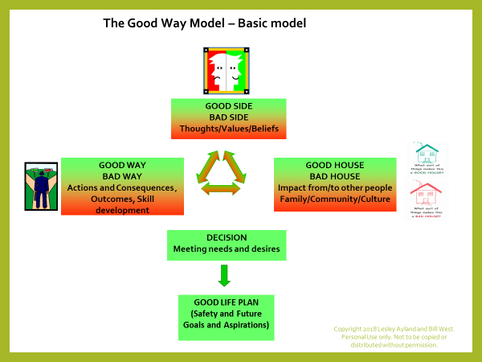What Is the Good Way Model?
The Good Way model is a strengths-based, attachment and trauma informed model.
It was originally developed by Lesley Ayland and Bill West at WellStop for clients that had cognitive or learning challenges, which may also be described as a “concrete” thinking style.
These days we use the Good Way model with children and adolescents generally, and adolescent and adult clients with an intellectual disability, and we have adapted it for use with cognitively able or typical youth and adult clients.
It was originally developed by Lesley Ayland and Bill West at WellStop for clients that had cognitive or learning challenges, which may also be described as a “concrete” thinking style.
These days we use the Good Way model with children and adolescents generally, and adolescent and adult clients with an intellectual disability, and we have adapted it for use with cognitively able or typical youth and adult clients.
Development of the Good Way Model
|
Click on the image for an expanded view
|
The Good Way model was developed out of concerns that mainstream cognitive models of practice did not meet the needs of clients with cognitive challenges.
Many of the approaches were too complex, even when adapted for this client group. It was our experience that even seemingly simple tasks, such as asking clients about their thoughts or feelings, was overwhelming for those who both struggled with the reflective skills to perform these tasks, and are more likely to have experienced trauma, which compounded their difficulty. |
The Basic Good Way Model Framework
The Good Way model uses the conceptual frameworks commonly articulated by our concrete-thinking clients to help them communicate with others about their world and conversely to understand what professionals, carers and families are trying to communicate to them.
The language of the Good Way model is based on that way our clients frame their understanding of the world, which tends to be literal and to view constructs in a dualistic manner: right-wrong, up-down, good-bad.
The language of the Good Way model is based on that way our clients frame their understanding of the world, which tends to be literal and to view constructs in a dualistic manner: right-wrong, up-down, good-bad.
|
The Good Way model proposes that everyone has a “Good Side” and a “Bad Side”, and that listening to and taking notice of one side or the other will lead us to act “the Good Way” or the “Bad Way” to meet our needs.
These actions may be helpful and positive, or harmful and negative, and the outcome (or “what happens after”) will take us towards, or away from our Good Life. |
Through a guided discovery process, clients learn there is a decision to be made before they act about whether to “listen to their Good Side and Go the Good Way” or to their “Bad Side and go the Bad Way”. This decision is made each time, and there is also a Big Decision – about the sort of person they want to be.
Almost all make the Decision that they want to strengthen and focus on the Good Side and move towards a Good Life. This decision is often based on learning about the impact for themselves of doing things the “Good Way” or the “Bad Way” and the way this contributes to their home, family and community: Good House or Bad House. Over time clients consider their own life experiences and ways these affect them.
They are also invited to reflect on or learn about their own cultural and spiritual beliefs and values. Family members, support people and others are asked to support the clients to develop their knowledge and understanding of their values (Good Side) and to build on their strengths.
They are also invited to reflect on or learn about their own cultural and spiritual beliefs and values. Family members, support people and others are asked to support the clients to develop their knowledge and understanding of their values (Good Side) and to build on their strengths.
The Good Way model helps the clients to acknowledge their own “Bad House” experiences where they were hurt or abused, and trauma specific techniques are used to assist the clients to come to terms with those experiences.
Clients come to understand that they may have contributed to the person they harmed having a Bad House, and are supported to make amends in a developmentally and culturally appropriate manner.
Throughout therapy we also acknowledge the “Good House” experiences they have had and work with family and those they live with ensure their current and future living situations are Good Houses, in which people in the home care for and support each other.
Clients come to understand that they may have contributed to the person they harmed having a Bad House, and are supported to make amends in a developmentally and culturally appropriate manner.
Throughout therapy we also acknowledge the “Good House” experiences they have had and work with family and those they live with ensure their current and future living situations are Good Houses, in which people in the home care for and support each other.
Therapuetic Process for the Good Way Model
The model uses guided discovery, drawing on the narratives and wisdom of clients and families to create stories which explain the past or guide them into the future. Therapy is creative and individualised, taking account of the client’s gender, culture, faith, family circumstances, interests, beliefs and values.
The focus is on collaborating with clients, their families and caregivers and communities to build resilience, resolve problems and mistakes, and to find strengths to develop a sense of themselves as being worthy of a good life.
The model provides a common language that enhances communication and helps parents and caregivers make sense of and manage any behavioural problems.
The focus is on collaborating with clients, their families and caregivers and communities to build resilience, resolve problems and mistakes, and to find strengths to develop a sense of themselves as being worthy of a good life.
The model provides a common language that enhances communication and helps parents and caregivers make sense of and manage any behavioural problems.
Evaluation of the Good Way Model
An independent qualitative review of New Zealand community-based programmes for adolescents who had engaged in harmful sexual behaviour was commissioned by Child Youth and Family (now Oranga Tamariki).
Jan Geary 2007 found that the model had high recall with the young people on the programme, who described the concepts to the researchers in considerable detail indicating they had understood and assimilated them.
One of the recommendations of the overall review was: That the Good Way Model be further developed so it can be used more extensively, with different client groups and across other programmes. (Geary and Lambie, 2006 p.5)
Jan Geary 2007 found that the model had high recall with the young people on the programme, who described the concepts to the researchers in considerable detail indicating they had understood and assimilated them.
One of the recommendations of the overall review was: That the Good Way Model be further developed so it can be used more extensively, with different client groups and across other programmes. (Geary and Lambie, 2006 p.5)
Client quotes from the Lambie and Geary Evaluation
- “It was good learning about going the Good Way and how it operates. The bad side is the guy who makes you go the bad way – it’s like they come and take over your life and make you do bad things, go the bad way and this leads to re-offending. And the good side – they make sure you do positive things and have a good life and make sure you don’t get into trouble and go to jail.” (Geary and Lambie 2006 p84)
- “It’s important for me to manage anger. They’ve got these three people that they give to you – My Sneaky, Mr Bully and Mr Just Do It. It helped me a lot. I wrote their profiles and some of them sounded like the things I used to do a lot e.g. I used to bully my brother and sister and other kids at school. I used to just do things that popped into my head”. (Geary and Lambie 2006 p85)
- “Learning my good side helped me a lot to deal with problems. If I get into a serious situation and think something’s gonna happen, then I go the good way and sort it out.” (Geary and Lambie 2006 p85)
Victoria Weedon's evaluation of the Good Way model
In 2015 Victoria Weedon conducted an evaluation of the Good Way model, as part of her PhD in psychology. This research was supported by funding from the Lotteries Grants Board .
Participants were 12 boys and young men aged between 11 and 17 years and their families at WellStop, (Wellington) and Stop (Christchurch). Of these:
By the end of the 3-year study, nine participants had completed treatment, two remained in treatment, and one had dropped out due to the impact of unstable placements.
The average treatment length was 7.5 months. The study looked at changes in risk of further Harmful Sexual Behaviour (HSB) and behavioural and psychological functioning as measured by a range of psychometric tools that were administered at assessment, at the beginning and end of treatment, and again 6 months after treatment ended.
Clients and families also completed two brief continuous measures on a weekly basis. Results from these measures across the group of participants were analysed and showed that use of the Good Way model was associated with a reduction in risk of further HSB and an increase in positively occurring behaviours related to strengths and resiliency.
For individual clients there was also evidence of change on measures of anxiety and depression. Positive results were shown on measures focusing on general outcomes (home, school, friends etc) and therapeutic alliance.
Overall, the findings indicate that the introduction of the Good Way Model intervention targeted the problem behaviour appropriately and that it was well received by participants.
Click here to read Victoria’s full thesis.
Participants were 12 boys and young men aged between 11 and 17 years and their families at WellStop, (Wellington) and Stop (Christchurch). Of these:
- Five participants had an intellectual disability
- Four had “special needs” e.g. a developmental or learning disability
- Three clients did not have an intellectual disability
- Six participants lived with a parent
- Three were living with extended family
- One was in foster-care
- One was in a group home
- One was in a Youth ID Forensic Inpatient Service.
By the end of the 3-year study, nine participants had completed treatment, two remained in treatment, and one had dropped out due to the impact of unstable placements.
The average treatment length was 7.5 months. The study looked at changes in risk of further Harmful Sexual Behaviour (HSB) and behavioural and psychological functioning as measured by a range of psychometric tools that were administered at assessment, at the beginning and end of treatment, and again 6 months after treatment ended.
Clients and families also completed two brief continuous measures on a weekly basis. Results from these measures across the group of participants were analysed and showed that use of the Good Way model was associated with a reduction in risk of further HSB and an increase in positively occurring behaviours related to strengths and resiliency.
For individual clients there was also evidence of change on measures of anxiety and depression. Positive results were shown on measures focusing on general outcomes (home, school, friends etc) and therapeutic alliance.
Overall, the findings indicate that the introduction of the Good Way Model intervention targeted the problem behaviour appropriately and that it was well received by participants.
Click here to read Victoria’s full thesis.
The Good Way Model Enquiry Form
If you have any questions or want to get in touch about training please send us an enquiry.

